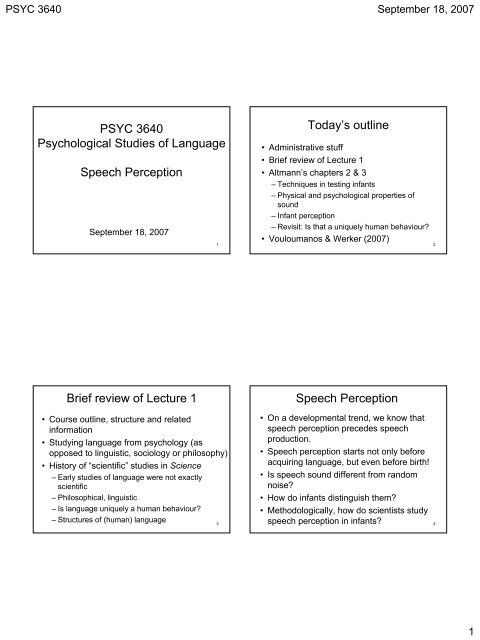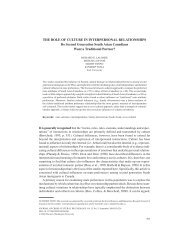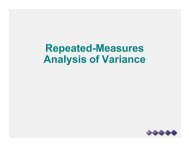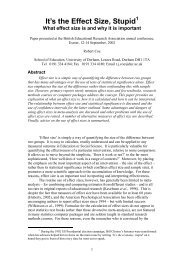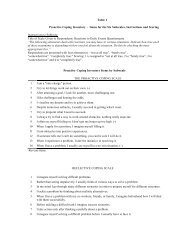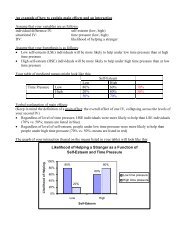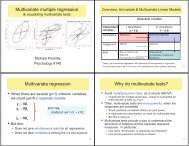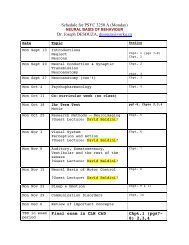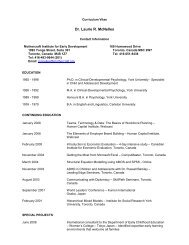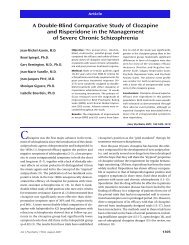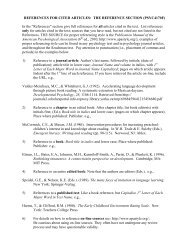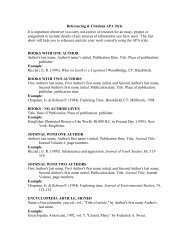Lecture 2 notes (pdf) - Department of Psychology
Lecture 2 notes (pdf) - Department of Psychology
Lecture 2 notes (pdf) - Department of Psychology
You also want an ePaper? Increase the reach of your titles
YUMPU automatically turns print PDFs into web optimized ePapers that Google loves.
PSYC 3640 September 18, 2007<br />
PSYC 3640<br />
Psychological Studies <strong>of</strong> Language<br />
Speech Perception<br />
September 18, 2007<br />
1<br />
Today’s outline<br />
• Administrative stuff<br />
• Brief review <strong>of</strong> <strong>Lecture</strong> 1<br />
• Altmann’s chapters 2 & 3<br />
– Techniques in testing infants<br />
– Physical and psychological properties <strong>of</strong><br />
sound<br />
– Infant perception<br />
– Revisit: Is that a uniquely human behaviour?<br />
• Vouloumanos & Werker (2007)<br />
2<br />
Brief review <strong>of</strong> <strong>Lecture</strong> 1<br />
Speech Perception<br />
• Course outline, structure and related<br />
information<br />
• Studying language from psychology (as<br />
opposed to linguistic, sociology or philosophy)<br />
• History <strong>of</strong> “scientific” studies in Science<br />
– Early studies <strong>of</strong> language were not exactly<br />
scientific<br />
– Philosophical, linguistic<br />
– Is language uniquely a human behaviour?<br />
• On a developmental trend, we know that<br />
speech perception precedes speech<br />
production.<br />
• Speech perception starts not only before<br />
acquiring language, but even before birth!<br />
• Is speech sound different from random<br />
noise?<br />
• How do infants distinguish them?<br />
• Methodologically, how do scientists study<br />
– Structures <strong>of</strong> (human) language<br />
3<br />
speech perception in infants?<br />
4<br />
1
PSYC 3640 September 18, 2007<br />
Testing Infants<br />
• What can babies do?<br />
• Non-nutritive sucking:<br />
Testing infants<br />
• Habituation/dishabituation: Infant’s sucking<br />
rate decreases after a stimulus is<br />
presented for some time. But the sucking<br />
rate increases again when a new stimulus<br />
is presented.<br />
• Possible problems <strong>of</strong> this technique?<br />
5<br />
6<br />
Hearing in utero<br />
• Human auditory system starts to function<br />
at around 7 months from conception.<br />
• But what’s it like hearing sounds in utero?<br />
7<br />
Sound<br />
• Vibration <strong>of</strong> air causes a vibration <strong>of</strong> a<br />
membrane in the inner ear<br />
• Frequency: number <strong>of</strong> occurrence in a given<br />
duration.<br />
• Amplitude: intensity <strong>of</strong> sound waves<br />
• Hz = cycle per second<br />
• Human (male and female combine) hearing<br />
frequency ranges from 20Hz to 20000Hz<br />
• Human speech ranges from 100Hz to<br />
4000Hz<br />
8<br />
2
PSYC 3640 September 18, 2007<br />
Sound<br />
Low<br />
Human Ear<br />
Freq.<br />
• Psychological property:<br />
High<br />
http://en.wikipedia.org/wiki/Frequency http://www.seahi.org/images/the_ear.gif<br />
9<br />
10<br />
Hearing in utero<br />
• Sounds are distorted in utero.<br />
• Prosodic factors:<br />
– Intonation melody <strong>of</strong> language<br />
“We aim to please. You aim too, please”<br />
(Fromkin & Rodman, 1974)<br />
– Rhythm depends on where the stress falls<br />
a computer un ordinateur konpyu-ta<br />
– Stress where the emphasis <strong>of</strong> a syllable falls<br />
“chimpanzee”<br />
• Prosodic variation: physical variation in<br />
sounds that triggers the psychological<br />
variation in intonation and rhythm.<br />
11<br />
Examples<br />
Dear Mum and Dad: Hi! How are you? Well, here I<br />
am in the big city. Although the weather is nice at<br />
the moment, the forecast is for hail, but that should<br />
soon clear. I bought a new coat yesterday because<br />
they say it gets really cold. I have to stay at Aunty<br />
Deb's house for now, but I'm hoping to get a flat<br />
soon. The trip up was great, even though it took<br />
ten hours. Well, I must go. You know how rarely I<br />
write, but I will try to do better this year. Love Clare<br />
http://www.otago.ac.nz/anthropology/Linguistic/Accents.html<br />
12<br />
3
PSYC 3640 September 18, 2007<br />
Speech perception in infants<br />
• (Mehler) Using the habituation/dishabituation<br />
method, it was shown that 4-days-old babies<br />
were able to distinguish two languages<br />
(French and Russian) based on familiarity<br />
before birth.<br />
• (DeCasper) Let pregnant mothers read<br />
stories for the last 6 weeks <strong>of</strong> pregnancy.<br />
Can the babies distinguish the prosody <strong>of</strong> the<br />
stories? YES!! They preferred the familiar<br />
Prosody<br />
• Why is it so important?<br />
• It tells us where does a word begin and end<br />
word boundaries<br />
• Syllables are the basic “sound boundaries” <strong>of</strong><br />
a word.<br />
– Syllable by itself can be meaningful or<br />
meaningless<br />
– Given a few meaningful syllables, their<br />
combination may nor may not mean the same<br />
thing by themselves.<br />
– Non-speech sounds do not have syllables <br />
distinguishing speech from non-speech sounds<br />
story.<br />
13<br />
14<br />
Syllable and Phoneme Perception<br />
• Babies can distinguish /p/ and /t/<br />
• [pat] ≠ [tap]<br />
• [pst] = [tsp]<br />
• Do you know <strong>of</strong> any word that has the<br />
syllables [pst] or [tsp]?<br />
• Illegal syllables are not distinguished by<br />
babies.<br />
• (Mehler) After adding a vowel that “legalize”<br />
one <strong>of</strong> the illegal syllables, [uptsu] vs. [utpsu],<br />
How do babies know?<br />
• Phoneme or syllable gene? Language<br />
gene?<br />
• Well, sickness runs in families, but so do<br />
many other things, like recipes and<br />
wealth… (Pinker, 1994)<br />
• Change in syllable ≈ Change in prosody<br />
• What’s in a syllable?<br />
babies can differentiate the two syllables. 15<br />
16<br />
4
PSYC 3640 September 18, 2007<br />
Infants vs. Adults<br />
• Experience?<br />
• Linguistic experience?<br />
• Vocabulary?<br />
• lexicon!<br />
• But does speech perception require<br />
lexicon? Not really…<br />
• Then, what’s so special?<br />
17<br />
Phoneme<br />
• Words/syllables with single different<br />
phonemes have different meanings:<br />
/mat/ /bat/<br />
• /b/ and /p/ differs in subtle vibrating action<br />
<strong>of</strong> the vocal folds<br />
• Voice onset time (VOT): The different<br />
timing when the vibrating action starts in<br />
the vocal folds. For voiced sounds, the<br />
vibration starts immediately. For voiceless<br />
sounds, it starts with a small delay.<br />
18<br />
Voice Onset Time (VOT)<br />
Phoneme perception illusion:<br />
The McGurk Effect<br />
"En pil"<br />
da<br />
ba<br />
ga<br />
"En bil"<br />
http://www1.ldc.lu.se/~logopedi/department/andy/Perturbations/VOT.html<br />
19<br />
20<br />
5
PSYC 3640 September 18, 2007<br />
Categorical Perception<br />
/b/<br />
20ms<br />
40ms<br />
/p/<br />
VOT<br />
21<br />
http://cfa-www.harvard.edu/~jbattat/a35/wavelength_color.html<br />
22<br />
Categorical Perception<br />
Phoneme Continuum<br />
• Vowel durations are generally longer than<br />
consonants.<br />
• Unlike consonants, vowels are perceived<br />
continuously rather than categorically.<br />
• (Studdert-Kennedy, 1975) Vowels carry<br />
stress, rhythm and prosody, which have<br />
an “echo” after production.<br />
/da/<br />
VOT<br />
/b/<br />
/d/<br />
/g/<br />
20ms<br />
40ms<br />
/p/<br />
/t/<br />
/k/<br />
phonetic stress, rhythm, prosody 23<br />
24<br />
6
PSYC 3640 September 18, 2007<br />
Categorical Perception<br />
• (Eimas) One-month-old babies can do it!<br />
• Not only in their only “native” languages,<br />
but also in “foreign” languages!<br />
• This ability is lost at about<br />
10 mos.<br />
Why categorical perception cannot be<br />
innate?<br />
• Non-speech sounds such as musical tones<br />
can also be perceived categorically.<br />
categorical perception is not limited to<br />
speech sounds<br />
categorical perception only applies to<br />
consonants, not vowels<br />
• Chinchillas do it too!<br />
not a uniquely human behaviour<br />
not speech-specific, but auditory-specific<br />
25<br />
26<br />
Kuhl & Miller (1975)<br />
Abstract: Four chinchillas were trained to respond<br />
differently to /t/ and /d/ consonant-vowel syllables<br />
produced by four talkers in three vowel contexts. This<br />
training generalized to novel instances, including<br />
synthetically produced /da/ and /ta/ (voice-on-set times<br />
<strong>of</strong> 0 and +80 milliseconds, respectively). In a second<br />
experiment, synthetic stimuli with voice-onset times<br />
between 0 and +80 milliseconds were presented for<br />
identification. The form <strong>of</strong> the labeling functions and the<br />
"phonetic boundaries" for chinchillas and Englishspeaking<br />
adults were similar.<br />
Kuhl, P. K., Miller, J. D. (1975). Speech perception by the chinchilla: Vocied-voiceless<br />
Distinction in alveolar plosive consonants. Science,190,69-72<br />
27<br />
Fixed Boundaries in Categorical Perception?<br />
• Boundaries <strong>of</strong> the /b/ (< 20ms) and /p/ (> 40ms)<br />
are influenced by speech rate.<br />
• Speech rate:<br />
– amount <strong>of</strong> time spent on articulating an<br />
utterance<br />
– number and length <strong>of</strong> pauses during utterance<br />
• Rate : vowel duration, VOT <br />
VOT , the boundary between voiced and<br />
voiceless consonants shifted towards the shorter<br />
end, hence harder to differentiate<br />
/g/ /k/ when rate <br />
28<br />
7
PSYC 3640 September 18, 2007<br />
Chapters 2 & 3<br />
• Sensitivity to language starts before birth.<br />
• Infants are sensitive to prosody in<br />
language(s) even before they are born.<br />
• After birth, infants show sensitivity to the<br />
smallest unit <strong>of</strong> spoken language, phoneme.<br />
• The ability to perceive phoneme<br />
categorically could be related to auditory<br />
system, not specially to speech.<br />
• Boundary in phoneme categories are<br />
context-dependent and can be influenced<br />
29<br />
by speech rate.<br />
Vouloumanos & Werker<br />
(2007)<br />
Listening to language at birth:<br />
Evidence for a bias for speech in neonates<br />
• Developmental Science, 10, 159-171<br />
30<br />
Introduction<br />
• Do babies show a bias to language, the<br />
communicative tool?<br />
• Previous suggested neonates could<br />
differentiate<br />
– speech from non-speech sounds<br />
– Other linguistic properties <strong>of</strong> speech<br />
•Brain<br />
• Not surprising that neonates chose folk<br />
Methods<br />
• Use physically comparable speech and nonspeech<br />
sounds as stimuli<br />
• Non-speech sounds are sine waves<br />
modeled after natural speech<br />
• Contingent sucking responses as preference<br />
for speech vs. non-speech sounds<br />
• 22 neonates (1-4 days old)<br />
• Tested 2 hours after feeding<br />
• Baseline: sucking amplitude in 1min silence<br />
• Stimulus presented when sucking amplitude<br />
music to white noise.<br />
31<br />
32<br />
is in the 80% <strong>of</strong> the baseline range<br />
8
PSYC 3640 September 18, 2007<br />
Timeline<br />
Speech vs. Non-speech Stimuli<br />
1 min<br />
4 mins 4 mins<br />
Baseline<br />
Experimental<br />
Block 1<br />
Experimental<br />
Block 2<br />
time<br />
silence<br />
Speech and non-speech stimuli<br />
alternate every minute<br />
33<br />
34<br />
Results<br />
Conclusion<br />
• Human neonates have a listening<br />
preference for speech.<br />
• Similar to other species’ adaptation to<br />
auditory signal from the same species.<br />
• Children who were later diagnosed to have<br />
language difficulty do not show this bias<br />
• Question 1: prenatal or experiential?<br />
• Question 2: what speech aspect was<br />
preferred?<br />
First 4 mins<br />
Last 4 mins<br />
35<br />
36<br />
9
PSYC 3640 September 18, 2007<br />
Rosen & Iverson’s commentary<br />
• Results crucially rely on the speech and nonspeech<br />
stimuli.<br />
• Revised conclusion: Neonates prefer to list to<br />
full-blown speech sounds compared to sinewave<br />
analogues.<br />
• Poor controls… there was no voice melody<br />
(prosody??) in the non-speech stimuli.<br />
• “Human neonates are biased to listen to<br />
sounds with a strong voice melody”<br />
V&W’s response<br />
• Voice melody (pitch) is a subjective<br />
perception. The component chosen in the<br />
stimuli was an appropriate formant to<br />
differentiate multiple natural speech.<br />
• Prenatal ≠ innateness<br />
• Using low-pass filtered (LPF) sounds<br />
stimuli, no preference was shown.<br />
• Information for discrimination is from high<br />
frequencies, which are not available in<br />
utero.<br />
• Preference develops in utero<br />
37<br />
38<br />
10


